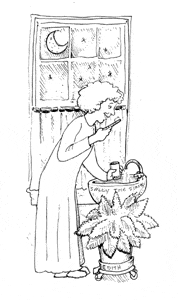STRANGE BUT TRUE- What's in a name? Humans love appellations

Q. Mare Moscoviense, Mare Ingenii, Jules Verne, Gagarin, Galois, Oppenheimer, Von Karman, Poincare, Mendeleev, Mach, Landau, Hertzsprung, Korolev, Van de Graaff, Apollo– the names are fascinating, taken from astronauts, astronomers, other scientists, alongside those from an occasional project (Apollo) or place (Moscoviense– Latin for Muscovy). But there's no Mare Nubium (Sea of Clouds) among them. Why? Where are you? –R. Heinlein
A. You're on or peering at the far side of the moon, contemplating the names of the major physical features there (craters, ridges, "sea" basins, etc.), wherein can be read the history of the space race, says David Crystal in The Cambridge Encyclopedia of the English Language. These names were not given until spacecraft first viewed the area in 1959. By contrast, there is little sign of the old romantic Latin descriptions (Mare Nubium) with which the familiar Earth side of the moon has long been identified.
There seems to be a universal and deep-rooted love for naming things, says Crystal, so much so that people have admitted naming their cars, word processors, house plants, kitchen implements, and on the "luna-tic" fringe, even their toothbrushes.
Q. In the history of interpersonal attraction, is "hooking up" really some new thing under the cultural sun, much in the media now, or more just old wine in new bottles? –C. Honey
A. If by "hooking up" you mean young people finding each other and becoming physical, "I think it's safe to say humans have been doing that for thousands of years, though some cultures approve of it more than others," says University of Waterloo anthropologist Harriet Lyons. Or do you mean professional and business people networking, making connections and trading favors–physical or not? Again, that is how humans advance their interests in many cultures.
Indeed, according to Annette Weiner, in the Trobriand Islands off the coast of New Guinea, definition 1 (finding each other) is seen as training in skills that will be useful when people mature and graduate to definition 2. The belief is that through learning to attract and please lovers, people become proficient in techniques that will help them "win friends and influence people" as adults.
Since the late 1960s, college dorm culture has been organized around men and women's relentless efforts to meet, date, become intimate, adds University of Nevada-Las Vegas anthropologist William Jankowiak. "In many ways students behavior is no different than chimps who are known to engage in brief consort relationships. The 'hooking up' is just a new term that arises whenever marriage is socially delayed. The experience is also common in Amazonian cultures, Polynesian societies, urban China, and Japan."
Q. When someone asks your age, you might flippantly reply, "What part of me? Some parts of me are younger than you might think, others are older than I like to admit." What's your "serious" point here? –Methuselah
A. Different cells of your body are at different ages, with most of them constantly being replaced, as verified by scientific isotopic carbon-14 dating, used to date trees,
reports The New York Times and Stanford chemist James P. Collman in Naturally Dangerous: Surprising Facts about
Food, Health and the Environment
. Going by this, most of your adult body is about 10 years old.Since all the carbon-14 in any cell's DNA is acquired on the cell's birth date, the extent of carbon-14 enrichment will yield a cell's age. Thus it has been found that the muscle tissues around a 30-year-old's ribs average about 15 years old, bones are generally about age 10, while red-blood cells of an adult last 120 days. Only a few of your cells last from birth to death, such as neurons in the cerebral cortex and maybe heart cells. Cell regeneration might seem the Fountain of Youth, but as DNA gets damaged through "mutations," the instructions for making new cells may become degraded. Other theories point to changes in mitochondria or stem cells.
Q. Biblical Goliath was said to stand "six cubits and a span" tall (1 Samuel 17:4). In feet and inches, and in centimeters, how high was that? –B. Cosby
A. The cubit was an ancient measure of length, the distance from the elbow to the tip of the middle finger of a person's outstretched arm, says Paul Campbell of Wisconsin's Beloit College, in For All Practical Purposes: Mathematical Literacy in Today's World. But which person?
A semblance of standardization set in, putting the cubit between 17 and 22 inches. The span was from the tip of the thumb to the tip of the little finger of a fully spread hand, or about 9 inches. Taken together, these suggest Goliath stood between 9-foot 3 and 11-foot-9, or 282 cm to 358 cm. "In modern times there have been men over 9 feet tall," he says.
But wait, this just in. According to Brigham Young University Humanities Newsletter and Notre Dame Magazine, the recent Dead Sea Scrolls translation puts Goliath at "four cubits and a span"– not six cubits– or more like 7 feet, still plenty imposing but much whittled down to size.
Send Strange questions to brothers Bill and Rich a .
#